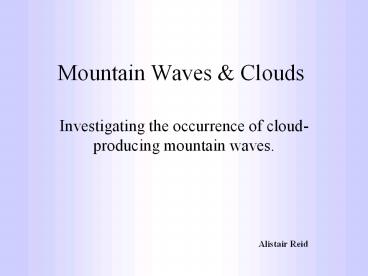Mountain%20Waves%20 - PowerPoint PPT Presentation
Title:
Mountain%20Waves%20
Description:
Mountain Waves & Clouds. Investigating the occurrence of cloud-producing mountain waves. ... Mountain (or Lee) Waves are formed by wind flowing over the ridge ... – PowerPoint PPT presentation
Number of Views:92
Avg rating:3.0/5.0
Title: Mountain%20Waves%20
1
Mountain Waves Clouds
- Investigating the occurrence of cloud-producing
mountain waves.
Alistair Reid
2
What is a mountain wave?
- Mountain (or Lee) Waves are formed by wind
flowing over the ridge of a mountain - May extend for many km downwind
- May extend high into the atmosphere (60,000ft)
- Vertically transverse waves wavelength 4-20km.
3
Observation of Mountain Waves
- Fly an aircraft into one!-in 1966 a mountain
wave ripped apart a Boeing 707 near Mt. Fuji in
Japan. - Look at the cloud formations
- Lenticular clouds
- Rotor clouds
- Pilatus cap clouds
4
New Zealands Mountain Ranges
Landcare Research images 4 times daily from NOAA
Satellite
http//satellite.landcareresearch.co.nz/noaa/
- I have searched the archived images for mountain
wave clouds. They most commonly occur at - Ruahine ranges
- Tararua ranges
- Southern Alps
5
Cap Clouds
Willowy pilatus clouds are often seen coming up
the windward face of a mountain.
Air is cooled as it is lifted up the mountain
face, usually at about 6o Celsius per km. When
the air cools to its dew point, the cap cloud
forms.
Why dont we see continuous pilatus clouds
downwind of the mountain?
?
6
The Foehn Effect
- The foehn effect often causes clouds to abruptly
cease upon reaching the summit. - frequently exhibited by the Southern Alps the
Nor-West Arch.
Air on the lee side of a mountain is
Warm The latent heat from the condensation of air
moisture makes the air warmer downwind (for the
same altitude). Dry Condensation has already
removed some of the airs water.
7
What causes a mountain wave?
1. A wind is pushed up the face of the mountain
- Must be within 30 degrees of perpendicular to the
mountain ridge - The wind must be strong at least 20-25 knots
(11-14ms-1)
In New Zealand, the winds are predominantly
nor-westers. Hence we find mountain wave clouds
from North-South ridges.
8
Buoyancy Waves
Once the air is displaced upwards, it will
oscillate around its initial altitude. A
vertical atmospheric wave is called a gravity
wave.
The temperature-altitude gradient The
temperature of the air in the troposphere
decreases with altitude. Air temperature
decreases when air is displaced upwards
adiabatically (no heat added).
The local air must be stable for standing waves
to occur.
9
Stability
The troposphere is stable if Adiabatic Lapse
Rate Troposphere Temperature Gradient
gt
- In a stable atmosphere
- When air is lifted adiabatically, it is cooler
than the surroundings and sinks - When air is lowered adiabatically, it is warmer
than the surroundings and rises
Each crest of a standing wave may be accompanied
by a Lenticular Cloud.
10
Amplitude Wavelength
- Observed wavelengths (from satellite data) range
from 4 to 20km - consistently around 15km over
the Tararua ranges - Main Wavelength factors wind speed and
atmospheric stability - A wavelength of 15km implies a wind speed of
roughly 30m/s (Beers Atmospheric Waves)
- Main Amplitude factors topography
- Wave amplitude depends mainly on the width of the
ridge, and also on height, altitude and wind
speed (Scorer). - Mountain waves can have resonance with mountains
placed an integer number of wavelengths downwind
from the source. (California)
11
Rotors
If the amplitude of the mountain wave is great
enough, rotors may form.
A rotor is a discrete vortex.
Rotor clouds are not visible from satellite
photographs, as they occur beneath the lenticular
clouds over the gravity wave crests.
Rotor Clouds may form at the rotor if the air is
moist enough.
12
Requirements
The observations of mountain wave clouds over New
Zealand are consistent with the theoretical
behavior of airflow over a mountain.
- Expect mountain waves when
- Wind is a strong breeze 11-14 ms-1 or greater
- The wind is blowing into the face of a suitable
mountain ridge - The atmosphere has a stable temperature gradient
- Or a low flying aircraft breaks into small pieces
Mountain wave clouds will occur when the air is
sufficiently moist.
13
(No Transcript)































